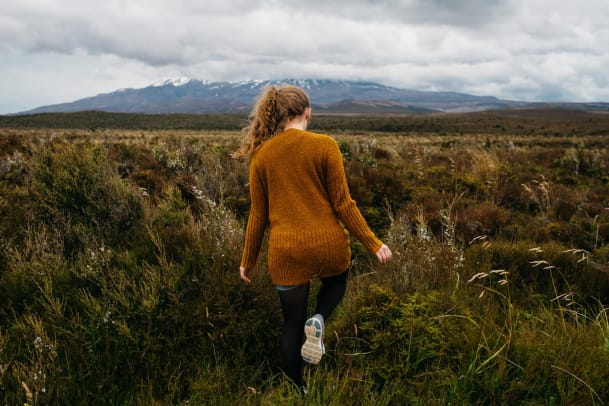
Leben
Die Natur kaputt – aber das Bild gepostet
- Text: Gabriella Alvarez-Hummel; Foto: Pablo Heimplatz on Unsplash
Sie missachten Naturschutzgesetze für das perfekte Foto — und sie sind auch in der Schweiz ein Problem: Influencer und jene, die es gern wären.
Irgendwo im Nordwesten der USA sitzt ein Mann am Computer, etwas über dreissig Jahre alt, beruflich im Umwelt- und Wissenschaftsbereich tätig, und zeigt in seiner Freizeit mit dem digitalen Zeigefinger auf andere. Seine Zielscheiben: Influencer, Prominente und Möchtegerns, die Blumen zertrampeln (oder sich nackt auf sie legen), auf Joshua Trees herumklettern (looking at you, Miley Cyrus) oder ihre Hunde und Drohnen unkontrolliert herumsausen lassen. Kurz: alle, die Naturschutzgesetze missachten.
Der Mann ist wütend. Darüber, dass Leute seine geliebten Plätze in der Natur vermüllen, dass sie wegen Social Media in Scharen über einstig einsame Orte herfallen, dass sie Flora und Fauna nicht respektieren. Deshalb durchkämmt er Instagram nach Verfehlungen. Entdeckt er eine Person, die offensichtlich für ein fulminantes Foto die Schutzgesetze ignoriert hat, startet er eine gnadenlose Kampagne über sein Profil Public Lands Hate You. Er fordert seine nahezu 70 000 Menschen starke Followerschaft dazu auf, die betreffende Influencerin mittels Kommentaren und Nachrichten über ihr Fehlverhalten zu informieren. Wurde das Bild zu Werbezwecken verwendet, wird auch das Profil des Sponsors geflutet à la: Wusstet ihr, dass mit eurem Geld die Natur zerstört wird? Nicht wenige Influencer haben deswegen lukrative Deals verloren. Weil er des öfteren bedroht wurde, bleibt der Mann anonym.
Die Wege zwischen den Mohnfeldern in der Walker-Canyon-Schlucht gab es früher nicht …
… sie entstanden durch Influencer, die sich ihre Wege durch die Blumen trampelten – für ein schönes Foto
Auch ein Schweizer Problem
Die sind eh alle so oberflächlich, die US-Amerikaner. Bei uns in der Schweiz passiert das nicht. Wir behandeln die Natur mit Respekt und kennen uns in den Bergen aus. Das dürfte die Meinung vieler hierzulande sein. Weit gefehlt, wie die Naturschutzorganisation Pro Natura berichtet. Auch in der Schweiz ist es ein zunehmendes Problem, dass Leute wegen Fotos die Regeln der Schutzgebiete missachten. Verbotenerweise werden Wege verlassen, Vegetation beschädigt, Wildtiere gestört, es wird campiert, kommerziell geshootet, Abfall liegen gelassen und Drohnen geflogen. Diese Probleme verstärken sich immer dann, wenn dank aufsehenerregender Instagram-Fotos auf einmal alle wie ferngesteuert dieselben Orte aufsuchen.
Davon betroffene grössere Schutzgebiete in der Schweiz sind laut Pro Natura:
– der Brienzergrat BE/LU mit den eidgenössischen Jagdbanngebieten Augstmatthorn und Tannhorn
– die Alpstein-Region SG/AI/AR
– das Muotathal SZ
– der Étang de la Gruère JU
– die Schutzgebiete am Südufer des Neuenburgersees VD/FR/BE
– der Creux-du-Van NE
– die Schutzgebiete um Derborence VS/VD
– der Aletschwald VS
All diese Orte sind total instagrammable. Aber sie alle sind eben auch mit den oben genannten Problemen konfroniert. Deshalb ist es auch nicht der Sinn, dass man nun umgehend all diese Orte googelt und aufsucht, um zu schauen, warum sich die Instagram-Jünger dort versammeln. Gutes tut, wer erst recht nicht hingeht.
Adieu, Geotag!
Sie haben einen wundervollen, kaum besuchten Ort entdeckt? Ein Vorschlag: Foto schiessen — natürlich innerhalb der Regeln des jeweiligen Schutzgebiets —, es getrost auf Instagram posten, aber darauf verzichten, es mit einem Geotag zu versehen. Diese Ortsangabe hat schon vielen schönen Plätzen auf der Erde den Frieden geraubt, wie an den oben genannten Schweizer Beispielen deutlich wird. Wenn jemand explizit nach dem genauen Standort fragt, kann man ihn natürlich weitergeben. Aber er muss ja nicht gleich dem gesamten Internet auf die Nase gebunden werden. Letztlich gibt es aber vor allem eine wichtige Sache zu tun, um nicht einer der Tölpel zu sein, die die Natur wegen Instagram buchstäblich mit den Füssen treten: sich informieren über die Regeln des jeweiligen Gebiets. Ausserdem gelten immer folgende zwei Regeln: erstens die Wege nicht verlassen, und zweitens Hunde an die Leine nehmen. Eine kinderleichte Merkhilfe ist, einfach nichts zu tun, was im eigenen Garten schmerzen würde.
Denn: Stellen Sie sich vor, Sie haben jahrelang Ihre Rosen umsorgt, Ihren Rasen Halm um Halm zu einem üppigen grünen Teppich kultiviert, Ihre Karnickel über Generationen gezüchtet — und dann postet irgendwann einer Ihrer Gäste ein Foto von Ihren Rosen und plötzlich trampeln lauter Leute achtlos Ihr Gras nieder, ein Rundel Hunde jagt Ihre Hasen und köpft dabei Ihre Rosen. In Sachen Naturschutz gehört der Garten eben nicht uns, sondern unserer Mutter – Mutter Natur. Und damit eben doch irgendwie auch uns. Der Punkt ist: Eine Person, die geschützte Blumen umknickt, in dessen Folge sie sich nicht vermehren können, ist nicht das Problem. Ein leinenbefreiter Hund ist es auch nicht. Aber wenn Tausende denken, sie seien nur eine Person, dann … eben.
Und seien wir ehrlich, wir sprechen hier von Fotos für Instagram, nicht von irgendwas von echter Wichtigkeit.






